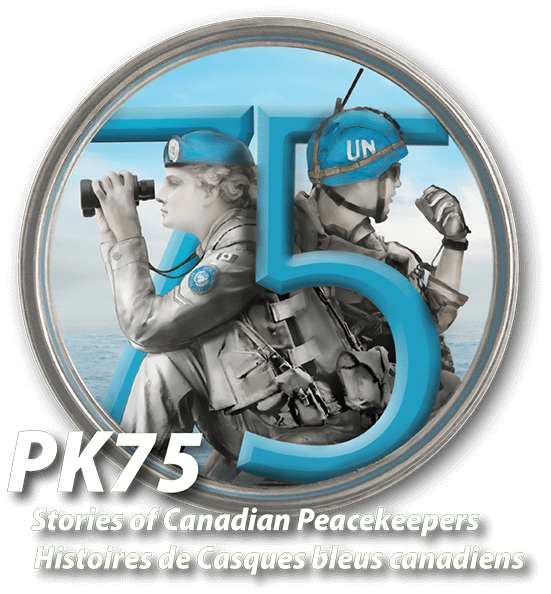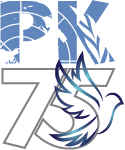

OP DANACA: The Deployment of the First Canadian Contingent to UNEF 2
In October 1973, I was a Major, Deputy Commander of 1st Canadian Signal Regiment. We were deployed to CFB Penhold on a major Canada/U.S. exercise and on TV watched the beginnings of the Yom Kippur/October War in the Sinai desert. Little did we know what awaited us…
Shortly after our return to Kingston, ON, I joined a planning conference at Mobile Command HQ working on a contingency plan for Canadian participation in a UN Force to supervise the cease-fire in the Middle East. After working away on a proposed Signals contribution to such a force, I was abruptly deployed to Egypt as the Signals member of the UN Secretary General’s Advisory Team. This multi-discipline team (Logistics, Engineer, Signals, Air Transport, Medical, etc.), commanded by BGen D.S. Nicholson, traveled to Cairo on 5 November to report on the resources needed to support a force of up to two brigades! I was accompanied by four operators from the Regiment to act as driver/secretarial support to the Team. Travelling by Hercules aircraft, we stopped in Cyprus to pick up three jeeps from our UN contingent there and pressed on to Cairo to begin our work. We were quartered in the Cairo Sheraton, the city still in wartime blackout, a surreal environment.
No sooner had we submitted our report and plan to UN HQ when we learned that the USSR had objected to this action by a NATO member and sent a similar team from Poland to provide political balance. With the benefit of the work we had already done, the UN Security Council decided to allot the force communications task to Canada (as well as supply, air transport and movement control). Poland was tasked to provide ground transport, engineers, and medical.
The Canadian Contingent was to be based on the Signal Regiment (for the HQ and Signal Squadron), a newly formed Service Unit and an Air Transport Unit, all augmented by significant engineering, logistic, medical, and other elements, all deployed through CFB Kingston.
My job as Advisory Team signals advisor complete, the Regiment’s operators and I converted into the ad hoc reconnaissance party for the Canadian Contingent. Exploring the teeming streets of Cairo, we soon got to know our way around and looked at several sites for the contingent, but most were unsuitable. On 11 Nov, we led the Advance Party to Shams racetrack in Heliopolis, a suburb of Cairo. It was the best location offered, with lots of room to camp, hard standing, water, etc.
Over the next three weeks, the remainder of our contingent (over 1000) deployed, and along with the Poles and the administrative support elements of all the units providing disengagement patrols in the Sinai, Camps Shams filled up quickly. I was reincarnated as the Canadian Camp Commandant dealing with the administrative support for our units and the daily life of a bustling camp.
Life on the outskirts of Cairo was never dull. Many of us were lucky enough to get to know local authorities and explore this teeming metropolis. After years of association with the USSR which had provided funding for such huge projects as the Aswan High Dam, the Egyptians we met were happy to re-encounter Canadians, as many had good memories of our service in UNEF I after the Suez Crisis. We met a hospitable group of US Presbyterians who welcomed us to their church at Christmas (I joined the choir after that!) and soon learned the warmth of true Arab hospitality. Occasional trips into Israel and Upper Egypt only whetted my appetite to learn more about this troubled part of the world.
The multi-national campground at Shams remained in place for almost four months. Then the support base moved to Ismailia (my last reconnaissance job before returning to Canada in Feb 1974). The HQ of UNEF II remained in Ismailia until its disbandment in 1979.
There is obviously much more to tell, and many others who could add to the saga. Suffice it to say that it was a unique and learning experience for a young Major and one for which I have many good memories.
Biography
I was born in Kingston, ON, in late 1942. My father was in the Army, and back in Canada for a year away from his only foreign posting: WW II. Growing up in Kingston and Ottawa, it seemed natural, after high school, to apply for Queen’s University, but also to the Royal Military College. I got two messages of acceptance: one from Queen’s asking for my first tuition payment and the other saying I should pick up a train ticket and head off for Royal Roads on the West coast! That train ride to Esquimalt began a military career of 37 years after I was commissioned in the Royal Canadian Corps of Signals in 1964.
As luck would have it, I never succeeded in landing a posting I asked for, but I wouldn’t change any place I’ve been. I was fortunate enough to spend all my time in the Army, until the rank of Lieutenant Colonel, mostly in operating units, including an exchange posting with the British Army in Northern Germany and command of the Headquarters and Signal Squadron in Valcartier (QGET 5 GBC) during the October Crisis in 1970.
I married my high school sweetheart who sacrificed a promising career herself to join me in Cold War travels from Valcartier to Kingston to Northern Germany to Brussels. We have two children born in Hanover and Kingston.
The UN operation I was involved in occurred when I was a Major (most Signal Officers had at least one, as Canada was always in demand to provide communications for the peacekeeping forces: a tribute to the outstanding professionalism of our soldiers).
My military education included Army Command and Staff College in Kingston, and the National Defence College. I spent most of the 1980s in Brussels, Belgium at NATO Headquarters, returning to command Canadian Forces Communication Command.
In June 1997, while serving in Ottawa, I retired from the Canadian Armed Forces (CAF) as a Major General after a satisfying career in Army operations, personnel policy, and communications-electronics, including service with UN, U.S., UK and NATO forces. I was appointed to the Order of Military Merit at the Grade of Commander (CMM) in 1993, and elected President of the CAF Communications-Electronics Association in 2020.
For several years after my retirement, I worked as a consultant, mainly for AFCEA Canada, an international association for information technology professionals. I was widowed after almost 50 years of marriage to Anne (Fletcher). I now do volunteer work in environmental protection, and our local church now occupies my time. My current hobbies include skiing, learning golf, and singing in the church choir.
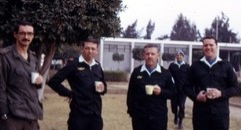
Coffee Break at Contingent HQ, Camp Shams Maj Mel MacLeod, Capt Chris Wellwood, Col George Simpson, Capt Tony Stasieciwiz, Maj John Leech.
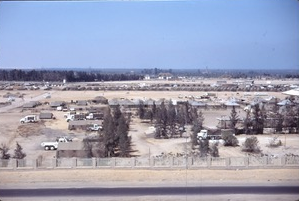
Canadian and Polish Lines at Shams Camp.
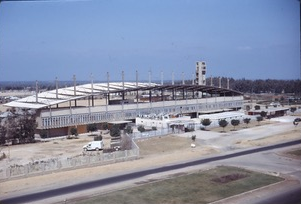
The stadium at Shams Camp.


